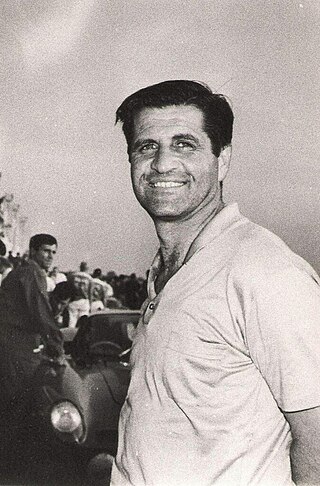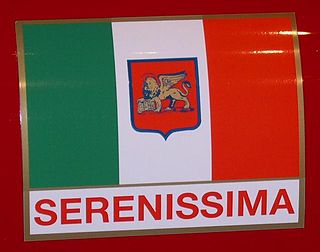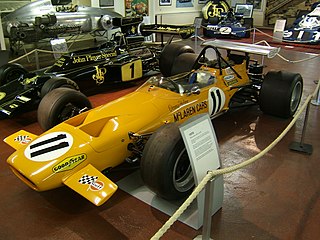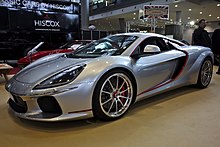Scuderia Ferrari is the racing division of luxury Italian auto manufacturer Ferrari and the racing team that competes in Formula One racing. The team is also known by the nickname "The Prancing Horse", in reference to their logo. It is the oldest surviving and most successful Formula One team, having competed in every world championship since 1950.

In automotive design, an RMR, or rear mid-engine, rear-wheel-drive layout is one in which the rear wheels are driven by an engine placed with its center of gravity in front of the rear axle, and thus right behind the passenger compartment. Nowadays more frequently called 'RMR', to acknowledge that certain sporty or performance focused front-engined cars are also "mid-engined", by having the main engine mass behind the front axle, RMR layout cars were previously just called MR, or mid-engine, rear-wheel-drive layout), because the nuance between distinctly front-engined vs. front mid-engined cars often remained undiscussed.

Giancarlo Baghetti was a Formula One driver who raced for the Ferrari, Automobili Turismo e Sport, BRM, Brabham and Lotus teams.

Bizzarrini S.p.A. was an Italian automotive manufacturer. In 1964, the company was founded by former Alfa Romeo, Ferrari and Iso engineer Giotto Bizzarrini. The company built a small number of highly developed and advanced sports and racing automobiles before failing in 1969. In 2020, it was announced that the name had been acquired by Pegasus brands, together with plans to restart production.

Giotto Bizzarrini was an Italian automobile engineer who was active from the 1950s through the 1970s.
Ferrari is an Italian company which has produced sports cars since 1947, but traces its roots back to 1929 when Enzo Ferrari formed the Scuderia Ferrari racing team.

Count Giovanni Volpi di Misurata is an Italian-Algerian nobleman and a former automobile racing manager and Formula One team owner. He inherited a fortune, at the age of 24, from his father, Count Giuseppe Volpi di Misurata, a politician financier and founder of the renowned Venice Film Festival. During World War II, Giovanni Volpi's father served in Benito Mussolini's cabinet as the minister of Finance and one of his chief advisors. He designed several of Mussolini's austerity measures and escaped prosecution after the war. His father also acquired and restored Villa Barbaro at Maser, Italy, built originally for the Barbaro family. Giovanni Volpi is the son of Giuseppe and his second wife, Nathalie El Kanoni.

Scuderia Serenissima or Scuderia SSS Republica di Venezia was an auto racing team funded by Giovanni Volpi and active in the early 1960s. The name "Serenissima" refers to one of the many definitions the city of Venice is known for, the Volpi family being originally from the area. Based in Sasso Marconi, close to Bologna, Serenissima mostly competed in Formula One and sports car racing. Originally the team had an engine supply agreement with Ferrari. When Volpi decided to financially support ATS, a Formula One team put together by Carlo Chiti, Giotto Bizzarrini, Romolo Tavoni and other breakaway Ferrari employees, Enzo Ferrari withdrew from the agreement. Serenissima subsequently turned to De Tomaso and Maserati without much success. Serenissima officially closed in 1970.

The Ferrari 250 GT SWB Breadvan is a one-off Ferrari made in 1962 from a 1961 Ferrari 250 GT Berlinetta SWB, chassis number 2819 GT. It was built to compete against the new 1962 Ferrari 250 GTO at the 24 Hours of Le Mans and other FIA World Sportscar Championship races.
The Alfa Romeo Tipo 33 was a sports racing prototype raced by the Alfa Romeo factory-backed team between 1967 and 1977. These cars took part for Sport Cars World Championship, Nordic Challenge Cup, Interserie and CanAm series. A small number of road going cars were derived from it in 1967, called Alfa Romeo 33 Stradale.

The 1962 24 Hours of Le Mans was a motor race for Experimental cars and Grand Touring cars, staged at the Circuit de la Sarthe, Le Mans, France on 23 and 24 June 1962. It was the 30th Grand Prix of Endurance and the eighth round of the 1962 International Championship of Manufacturers.

Mauro Forghieri was an Italian mechanical engineer, best known for his work as a Formula One racing car designer with Scuderia Ferrari during the 1960s and 1970s. He is credited with introducing the first designed rear wings to Formula One at the 1968 Belgian Grand Prix. He oversaw numerous technical developments during his tenure at Ferrari, including the creation of the 250 GTO and P-series sports racing cars, the Ferrari flat-12 series of engines, Ferrari's first turbocharged engine in the 126 C F1 car, and a prototype semi-automatic transmission in 1979. During Forghieri's tenure with Ferrari, the company won the F1 World Driver's Championship four times and the F1 World Constructors' Championship seven times. After leaving Ferrari in 1987, he worked at Lamborghini and Bugatti then founded the Oral Engineering Group in 1995.

Carlo Chiti was an Italian racing car and engine designer best known for his long association with Alfa Romeo's racing department. He also worked for Ferrari and was involved in the design of the Ferrari 156 Sharknose car, with which Phil Hill won the 1961 championship.
Italian motor manufacturer Alfa Romeo has participated multiple times in Formula One. The brand has competed in motor racing as both a constructor and engine supplier sporadically between 1950 and 1987, and later as a commercial partner between 2015 and 2023. The company's works drivers won the first two World Drivers' Championships in the pre-war Alfetta: Nino Farina in 1950 and Juan Manuel Fangio in 1951. Following these successes, Alfa Romeo withdrew from Formula One.

Autodelta SpA was the name of Alfa Romeo's competition department. Established in 1961 as Auto-Delta by Carlo Chiti and Lodovico Chizzola, former Alfa Romeo and Ferrari engineers, the company was officially made a department of Alfa Romeo on March 5, 1963 by the then president of Alfa Romeo Giuseppe Luraghi. Originally based in Feletto Umberto, Udine, the team subsequently moved closer to Alfa Romeo's facilities in Settimo Milanese in 1964, officially becoming Autodelta SpA. The move enabled Autodelta to use the Balocco test track for new racing cars and prototypes.

The ATS 2500 GT is a sports car made by Italian company Automobili Turismo e Sport in Bologna. It was the first Italian and one of the first GT or sports car in the world to have a mid-engine layout. The group behind the ATS project consisted mainly of Ferrari defectors: family troubles had created an uncomfortable working atmosphere for the personnel. ATS, intent on beating Ferrari on all fronts, also produced a Formula One car for 1963, "a ghastly mess, one of the most inept racing cars ever, and its appalling performances did not help the road car." Even noted driver Phil Hill was unable to provide ATS with any results on track.

The McLaren M14A is a Formula One racing car built and raced by McLaren in the 1970 World Championship and the 1971 World Championship. A later extension, the McLaren M14D featured a V8 Alfa Romeo engine.
Neri and Bonacini, also known as Nembo, was a small carrozzeria and mechanic shop based in Modena, Italy, active from the late 1950s to around 1967. Founded and run by Giorgio Neri and Luciano Bonacini, the shop worked on and produced bodies for Ferrari, Lamborghini and Maserati road and race cars, both in an official capacity for those manufacturers and for private owners. Their best known projects are the Ferrari 250 GT-based Nembo spiders and the Lamborghini 400GT Monza. Neri and Bonacini also designed a car under their own name, the Neri and Bonacini Studio GT Due Litri. Two prototypes of this car were made between 1966 and 1968 but it never entered series production. The shop closed around 1967 when Bonacini went to work for De Tomaso and Neri started his own shop, Motors-World-Machines (MWM).

The ATS GT is a sports car manufactured by Italian automobile manufacturer Automobili Turismo e Sport (ATS). Introduced in 2017, the car pays homage to the company's first and only production model to date, the ATS 2500 GT.

Alfa Romeo has made three 8-cylinder Grand Prix racing engines designed for both Formula One and sports car racing; in both inline and V engine configurations. Their first was the supercharged 158/159, a straight-eight engine, with the 1.5 L engine configuration imposed by the FIA for forced induction engines, in 1950. After a 20-year gap, their second engine was the Tipo 33 engine, a 3-liter naturally-aspirated V8 engine, in 1970. Their third and final engine was the turbocharged 890T V8 engine in 1983, which was used by both Alfa Romeo until 1985, and Osella until 1988, until Alfa Romeo eventually pulled out of F1 that same year.



















